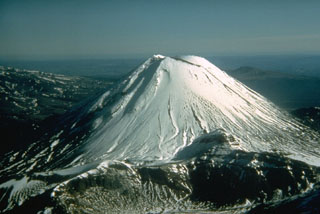Report on Tongariro (New Zealand) — July 1993
Bulletin of the Global Volcanism Network, vol. 18, no. 7 (July 1993)
Managing Editor: Edward Venzke.
Tongariro (New Zealand) Fumarole temperatures decrease
Please cite this report as:
Global Volcanism Program, 1993. Report on Tongariro (New Zealand) (Venzke, E., ed.). Bulletin of the Global Volcanism Network, 18:7. Smithsonian Institution. https://doi.org/10.5479/si.GVP.BGVN199307-241080
Tongariro
New Zealand
39.157°S, 175.632°E; summit elev. 1978 m
All times are local (unless otherwise noted)
The following ... is based on fieldwork in late March and early May 1993. "Activity in the crater of Ngāuruhoe has declined further over the past year and is at an all time low since records were first kept. Fumarole temperatures have decreased to 90°C after remaining stable at 94°C (boiling point for altitude) since 1986. No volcanic deformation was identified by surveys to points on the crater rim and at the base of the mountain."
Geological Summary. Tongariro is a large volcanic massif, located immediately NE of Ruapehu volcano, that is composed of more than a dozen composite cones constructed over a period of 275,000 years. Vents along a NE-trending zone extending from Saddle Cone (below Ruapehu) to Te Maari crater (including vents at the present-day location of Ngauruhoe) were active during several hundred years around 10,000 years ago, producing the largest known eruptions at the Tongariro complex during the Holocene. North Crater stratovolcano is truncated by a broad, shallow crater filled by a solidified lava lake that is cut on the NW side by a small explosion crater. The youngest cone, Ngauruhoe, is also the highest peak.
Information Contacts: B. Christenson, I. Nairn, P. Otway, and B. Scott, IGNS, Wairakei.

